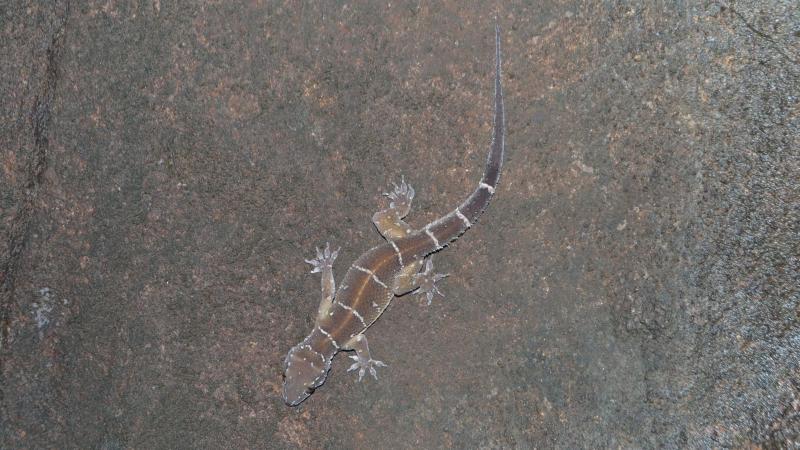
Life around us is relentlessly diverse and the discovery of many new species every year supports this fact. The reptile world, so far, has about 10,800 species and the count has grown by 20% since the last decade. Hemidactylus, a genus of reptiles that includes the house geckos, is a diverse one with about 150 species spread over a wide geographic range. However, there still exist a few ‘cryptic’ species, where individuals of one species are identical to ones from another species by looks. Scientists use taxonomic and molecular studies to unravel this puzzle for species conservation.
In one such study, a team of researchers from the National Centre for Biological Sciences (NCBS), Bengaluru, Fergusson College, Pune and Veer Narmad South Gujarat University, Gujarat, have unravelled the taxonomy of Hemidactylus triedrus, a gekkonid lizard belonging to the genus Hemidactylus, commonly known as the termite hill gecko. The study was published in the journal PeerJ and was supported by the Singinawa Conservation Foundation and the Department of Science and Technology.
H. triedrus comprises of a group of closely related species spread over a wide geographical area including parts of Pakistan, India and Sri Lanka. Several species were thought to represent H. triedrus leading to taxonomic confusion, which has now been successfully resolved. “My colleagues and I have been working on documentation of reptiles across peninsular India. The fascination that my colleagues and I have for reptiles and documenting its diversity was the main motivation behind this study”, shares Mr Zeeshan Mirza, a researcher from NCBS and an author of the study.
The taxonomy of H. triedrus has an exciting history. The first description of this species was of a male by an unknown collector. Another researcher described a species from Nellore, Andhra Pradesh as H. subtriedrus and marked it as a distinct species without much molecular or morphological evidence. Thus, the validity of H. subtrierdus as a species was questioned. Following this, in 1871-72, another researcher reported H. subtriedrus from Erode, Tamil Nadu. In 1905, Nelson Annandale, a Scottish herpetologist, regarded the specimen from Erode as one that is an intermediate between H. triedrus and H. subtriedrus. However, in due course, the type specimen, based on which the description of subsequent discoveries of Hemidactylus genus is made, was lost from Annandale’s list of Indian gekkonid collection.
William Theobald, a naturalist and staff of the then Geological Survey of India and Burma, presented two accounts of the species concerning Hemidactylus; H. subtriedrus Jerdon (1853) and H. subtriedrus Theobald (1876). Hemidactylus triedrus lankae, the Sri Lankan population, was attributed as a subspecies of H. triedrus. Another group of researchers proposed the validity of H. subtriedrus without any morphological data and declared that H. triedrus lankae was a species. Nonetheless, the specimens of H. triedrus lankae, based on which the nomenclature is carried out, are now missing or lost, making identification impractical.
In this study, the researchers set out to verify whether H. subtriedrus is a species by itself. They started by collecting a male specimen from Nellore, Andhra Pradesh, where the first specimen of this species was described and compared it with existing museum specimens. Given the widespread distribution and heterogeneity of landscapes in which the species is found, they also collected H. triedrus specimens from Pondicherry, Chennai, Maharashtra, Karnataka, Andhra Pradesh and Gujarat. Upon observation, they found that the specimen from Nellore was identical to those collected from Pondicherry and Chennai, confirming that H. subtriedrus is a synonym of H. triedrus, implying that both are the same species.
To provide evidence to the claim, the researchers recorded body measurements and meristic data like counting the scales, from the collection and museum specimens, followed by analysis of DNA that included a haplotype network to identify variations in the genes that accounts for new species. “A haplotype network is an analysis to identify distinct clusters within a population that might represent distinct species as in our case. In many cases, it is also used to evaluate gene flow from the source population which gives rise to distinct populations”, explains Mr Mirza. Morphological data and anatomy of the skull also underpinned the same.
The results revealed two new species in addition to H. triedrus—the highlight of the study. H. triedrus sensu stricto comprises of individuals from Nellore, Pondicherry and Sri Lankan, while the new species, called H. whitakeri sp. nov. and H. sahgali sp. nov. comprised of populations from from Karnataka, and Maharashtra, Gujarat and parts of Pakistan respectively.
What are the distinct characteristics of these new species? “Males of most gecko species possess a series of scales with a single pore around the cloacal region, and these may extend to the thigh of the animal. These pores are important diagnostic characters, and each species has a fixed number of these pores”, says Mr Mirza. So, H. sahgali bears 11-15 of these pores and the other two species, H. triedrus and H. whitakeri bear 6-9. On the other hand, H. triedrus has trihedral tubercles, large modified scales which look like pimples, on their back whereas H. whitakeri has sub-trihedral tubercles.
The researchers believe that more work needs to be done regarding the discovery. “We are interested in defining the distribution of each of these species as there is limited data on the distribution, especially for H. whitakeri and H. triedrus. It will be interesting to find out if the ranges of these two species overlap or if they share the same habitat. Results from these will help formulate more interesting projects to study competition, hybridisation etc.”, says Mr Mirza before signing off.






